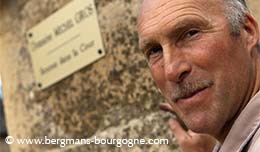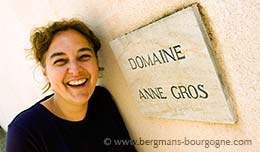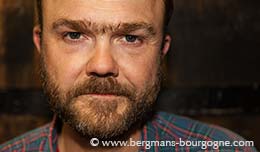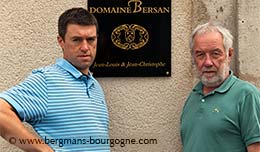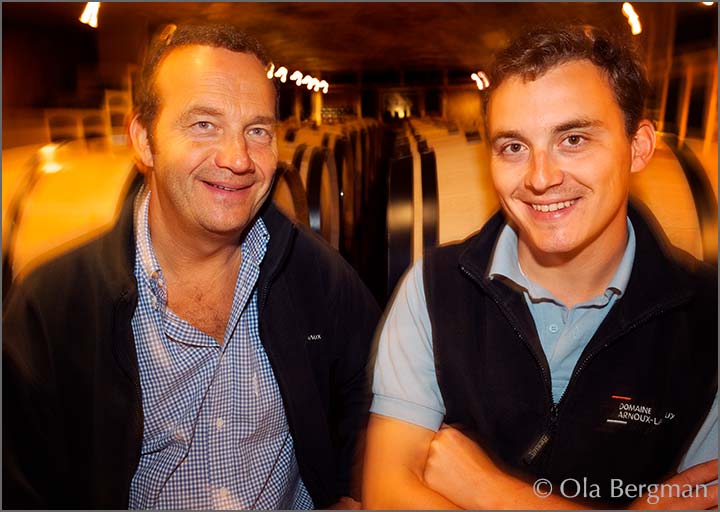
here was a time when this domaine produced Grands Suchots. Back when the rules were less strict, and Domaine Arnoux-Lachaux in Vosne-Romanée was still called Domaine Arnoux-Salbreux, this was what it said on some of the labels. Today the labels are less grand, stating Vosne-Romanée premier cru Les Suchots. But the vineyard is the same.
 – Les Suchots is kind of the mascot of the domaine, says Pascal Lachaux. The vines are old, about 80 years, and it is an extraordinary parcel, about as well-located as it can be in this village. The grandparents used to call it Les Grands Suchots or Les Hautes Suchots. Today you are not allowed to use those names.
– Les Suchots is kind of the mascot of the domaine, says Pascal Lachaux. The vines are old, about 80 years, and it is an extraordinary parcel, about as well-located as it can be in this village. The grandparents used to call it Les Grands Suchots or Les Hautes Suchots. Today you are not allowed to use those names.
The parcel in question is the top part of Les Suchots. It is the continuation of Romanée-Conti and Richebourg to the north. The labels saying Grands Suchots were used in the 1950’s when Charles Arnoux was running the domaine. There was no mention of either Vosne-Romanée or premier cru on those.
– No matter which year Les Suchots always produces millerande grapes (bunches contain berries that differ greatly in size) with thick skins, says Pascal Lachaux. That’s Les Suchots for you.
 Today Domaine Arnoux-Lachaux covers 14.5 hectares and 15 appellations. The most recent acquisition was 0.53 hectare of Latricières-Chambertin in 2008. Pascal Lachaux arrived at the domaine in 1987, where he worked together with his father-in-law Robert Arnoux. In 1995 Robert Arnoux passed away and in 2007 the name was changed from Domaine Robert Arnoux to Domaine Arnoux-Lachaux. For a short period Pascal Lachaux also ran a négociant business.
Today Domaine Arnoux-Lachaux covers 14.5 hectares and 15 appellations. The most recent acquisition was 0.53 hectare of Latricières-Chambertin in 2008. Pascal Lachaux arrived at the domaine in 1987, where he worked together with his father-in-law Robert Arnoux. In 1995 Robert Arnoux passed away and in 2007 the name was changed from Domaine Robert Arnoux to Domaine Arnoux-Lachaux. For a short period Pascal Lachaux also ran a négociant business.
– We stopped that a few years ago, he explains. The idea was to buy grapes from appellations in the Côte de Nuits we didn’t have at the domaine, like Bonnes Mares, Richebourg, Mazis-Chambertin, Chambertin Clos de Bèze and Chambolle-Musigny premier cru. It continued for seven years before we decided to stop. It became too difficult to find grapes, too expensive.
The history of the domaine goes back some 150 years. The first cellar was built in late 19th century, around 1885-1887. Today it is the smallest cellar at the domaine, but back then it was enough to store the few barrels they kept.
 – In the 19th century there wasn’t a cooperative to sell the wine to, says Pascal Lachaux. But the wine was sold to others here in Vosne-Romanée. It wasn’t until the late 1950’s/early 1960’s that the whole production was bottled at the domaine. The oldest bottles we still have are from 1900, 1913 and 1917.
– In the 19th century there wasn’t a cooperative to sell the wine to, says Pascal Lachaux. But the wine was sold to others here in Vosne-Romanée. It wasn’t until the late 1950’s/early 1960’s that the whole production was bottled at the domaine. The oldest bottles we still have are from 1900, 1913 and 1917.
In October 2011, after wine school and various stints abroad, Charles Lachaux joined his father at the domaine. Since the 2012 vintage he is in charge of vinification at Domaine Arnoux-Lachaux. His arrival means some changes. Whole bunch fermentation has been introduced and Pascal Lachaux is very happy with the results this far.
 – I find it very interesting, he says. We have been using between 30 and 100 per cent whole bunches. In general the vinfication is very simple here. If you have healthy grapes it takes care of itself. We are very hands-off in our approach, so there is not really very much to say about it. Just basic.
– I find it very interesting, he says. We have been using between 30 and 100 per cent whole bunches. In general the vinfication is very simple here. If you have healthy grapes it takes care of itself. We are very hands-off in our approach, so there is not really very much to say about it. Just basic.
With the exception of the Latricières-Chambertin all vines are located in Vosné-Romanée and the neighbouring villages of Nuits-Saint-Georges, Flagey-Echezeaux, Vougeot and Chambolle-Musigny. All are owned. The only grapes they buy are those for the generic red Bourgogne, where they don’t have enough vineyards themselves.
 – For the Bourgogne we don’t use any new oak, says Charles Lachaux. The vines are between 50 and 60 years old. Half of them are located in Chambolle-Musigny, 25 per cent in Vosne-Romanée and 25 per cent in Nuits-Saint-Georges. We don’t own enough vines to begin with and in addition to that we uprooted close a hectare in 2011. In 2014 that parcel will be replanted.
– For the Bourgogne we don’t use any new oak, says Charles Lachaux. The vines are between 50 and 60 years old. Half of them are located in Chambolle-Musigny, 25 per cent in Vosne-Romanée and 25 per cent in Nuits-Saint-Georges. We don’t own enough vines to begin with and in addition to that we uprooted close a hectare in 2011. In 2014 that parcel will be replanted.
– Except for the Bourgogne rouge we treat all wines the same way, he continues. After élevage they all stay in barrels for 14 months, with different amounts of new oak. The village Vosne-Romanée sees 20 per cent new oak, while the Nuits-Saint-Georges premier cru Clos des Corvées Pagets sees 40 per cent. Les Suchots and Aux Reignots in Vosne-Romanée, and the grand crus, all get 100 per cent new oak.
The village Vosne-Romanée comes from two large parcels in Les Saules and Les Communes, and a very small parcel in Bossières.
– The two large parcels unfortunately had problems with frost in 2009, says Pascal Lachaux. Many vines died because of it. So for the coming decade there will be a shortage of village Vosne-Romanée wine, because it was not just our domaine that was affected. Some domaines, like Mugneret-Gibourg, had to uproot a lot, close to 100 per cent.
 – These parcels have pretty much the same kind of soil, says Charles Lachaux. The same colour, the same mix of clay and limestone. As you move north in the Vosne-Romanée village appellation the soil contains more sand. It is lighter in colour. The soil gets more structure and is less heavy.
– These parcels have pretty much the same kind of soil, says Charles Lachaux. The same colour, the same mix of clay and limestone. As you move north in the Vosne-Romanée village appellation the soil contains more sand. It is lighter in colour. The soil gets more structure and is less heavy.
The Nuits-Saint-Georges premier cru Clos des Corvées Pagets is the southernmost parcel of the domaine’s holdings. You’ll find it in the part of the Nuits-Saint-Georges appellation that is in Premeaux-Prissey.
– It is very stony, with lots of sand, says Charles Lachaux. It produces a wine with soft tannins. The vines are 60 years old and with a soil like that they have to struggle. The yield is low, but always very concentrated.
The Romanée-Saint-Vivant parcel of Domaine Arnoux-Lachaux is just below the Romanée-Conti. With its 9.30 hectares Romanée-Saint-Vivant is the largest of the Vosne-Romanée grand crus. Domaine Arnoux-Lachaux owns 0.34 hectare, a parcel they have been farming since 1927 or 1928. The grapes are small and annual production is four or five barrels. In rare cases as much as five and a half barrels. Like their Vosne-Romanée Aux Reignots and the old vines part of Latricières-Chambertin it is ploughed by horse.
– Romanée-Saint-Vivant needs time to come around, says Pascal Lachaux. Les Suchots is always good, both young and old, even though it is a bit more reserved in its youth.
© 2013 Ola Bergman










